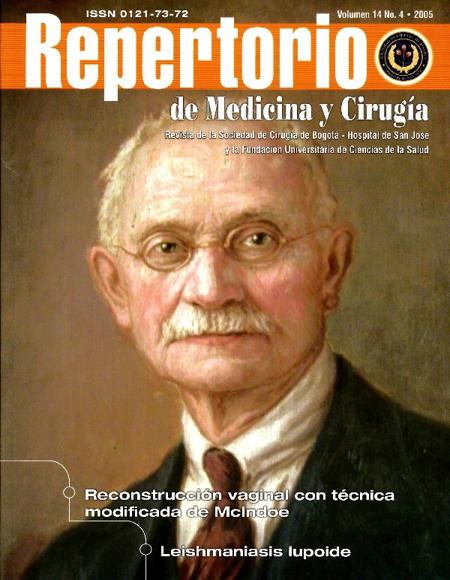Leishmaniasis lupoide
Lupoid leishmaniasis
Esta obra está bajo una licencia internacional Creative Commons Atribución-NoComercial-CompartirIgual 4.0.
Mostrar biografía de los autores
La primera descripción de leishmaniasis en América Latina fue hecha por Migone en 1913 y en Colombia en 1944 por Augusto Gast-Galvis. Hasta el momento, ha sido registrada en 88 países del mundo, donde ocurren anualmente alrededor de 12 millones de casos y existen aproximadamente 350 millones de personas en riesgo de contraer la enfermedad. En los últimos cinco años, se han reportado alrededor de 6.500 casos nuevos en Colombia. Se realiza el recuento histórico del caso de una mujer de 27 años con el diagnóstico de leishmaniasis vegetante centrofacial, tratada en 1935 con telecuriterapia en el Instituto Nacional de Radium.
Visitas del artículo 395 | Visitas PDF 445
Descargas
1. Altamirano-Enciso AJ, Marzochi MC, Moreira JS, Schubach AO, Marzochi KB. On the origin and spread of cutaneous and mucosal leishmaniasis, based on preand postcolombian historical source. Hist Cienc Saude Manguinhos 2003;10(3):852-82.
2. Weigle K, Saravia NG. Natural history, clinical evolution, and the hostparasite interaction in New World cutaneous Leishmaniasis. Clin Dermatol 1996;14(5):433-50.
3. Gast Galvis A, Rengifo S. Leishmaniasis visceral. Estudio epidemiológico del primer caso estudiado en Colombia. An Soc Biol (Bogotá) 1944;1:161-168.
4. Weigle KA, Santrich C, Martinez F, Valderrama L, Saravia NG. Epidemiology of cutaneous leishmaniasis in Colombia: a longitudinal study of the natural history, prevalence, and incidence of infection and clinical manifestations. J Infect Dis 1993;168(3):699-708.
5. World Health Organization. Leishmaniasis around the world. Disponible en http://www.who.int/zoonoses/diseases/leishmaniasis/en/
6. Ministerio de Protección Social Instituto Nacional de Salud Sistema de Vigilancia en Salud Pública. Situación epidemiológica de las enfermedades transmisibles por vectores en Colombia Boletín Epidemiológico Semanal 22 de feb 2004 — 28 feb 2004 p. 9-11
7. Markle WH, Makhoul K. Cutaneous leishmaniasis: recognition and treatment. Am Fam Physician 2004;69(6): 1455-60.
8. Cavina Pratesi A, Mariotti G. Contribution to the study of roentgenotherapeutic treatment in cutaneous leishmaniasis. Radiobiol Radioter Fis Med 1961;16:334-48.
9. Silveira FT, Lainson R, Corbett CE. Clinical and immunopathological spectrum of American cutaneous leishmaniasis with special reference to the disease in Amazonian Brazil: a review. Mem Inst Oswaldo Cruz 2004; 99(3):239-51.
10. Desjeux P. Leishmaniasis. Nat Rev Microbiol 2004; 2(9):692.
11. Dallaire P. Population control. World Pop Con 1999;12(2): 112-118.
12. De Almeida MC, Vilhena V, Barral A, Barral-Netto M. Leishmanial infection: analysis of its first steps. A review. Mem Inst Oswaldo Cruz 2003; 98(7):861-70.
13. Steck EA The chemotherapy of protozoan diseases.Walter Reed Army Institute of Research. Division of Medicinal Chemistry, 1972 T2 pp 7.1-7.90
14. Rodriguez ME, Inguanzo P, Ramos A, Perez J. Treatment of cutaneous leishmaniasis with CO2 laser radiation. Rev Cubana Med Trop 1990; 42(2):197-202.
15. Kasimova NA. Experience in treating cutaneous leishmaniasis by using low-energy laser radiation. Voen Med Zh 1990;(6):52.
16. Haas LF. August von Wassermann (1866-1925). J Neurol Neurosurg Psychiatry 2003;74(8):1104.
17. Lowy I. Scientific facts and their public: the history of the diagnosis of syphilis. Rev Synth 1995;116(1):27-54.
18. Cates W Jr, Rothenberg RB, Blount JH. Syphilis control. The historic context and epidemiologic basis for interrupting sexual transmission of Treponema pallidum. Sex Transm Dis 1996;23(1):68-75.
19. Schwartz R. Paul Ehrlich's Magic Bullets. N Eng J Med 2004;350(11):1079-1080.
20. Altamirano AJ. "Comprometiendo la estructura Osteo-Facial de las Poblaciones Humanas del Antiguo Perú por la Leishmaniasis Tegumentaria de forma mucosa y su Significado Cultural". Tese apresentada ao curso de Doutorado em Saúde Pública da Escola Nacional de Saúde Pública da Funda0o Oswaldo Cruz, 2002. p. 108.













